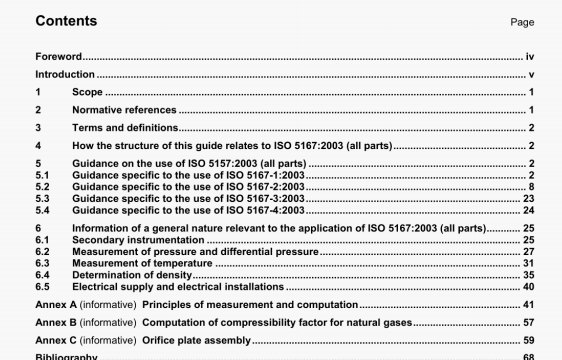ISO 9464 pdf download – Guidelines for the use of ISO 5167:2003.
5.2.5.1.8.3 To enable the requirements of this subclause (i.e. 0.05 % difference) to be shown to have been met, it is necessary to measure or compare with an uncertainty of at most 0.02 %.
5.2.5.1.9 BIdirectional plates
5.2.5.1.9.1 A symmetrical plate is Intended to be used for the measurement of a fluid that may flow In either direction. Such a plate should not be bevelled.
The thickness, E, of the plate should then not be greater than 0,020. As a consequence, symmetrical plates should only be used with low values of differential pressure to prevent deformation (see ISO 5167-2:2003,
5.1.2.3).
5.2.5.1.9.2 The appropnate tappings for the direction of flow should be used
5.2.5.1.10 Material and manufacture
Subclause 5.1.6.1.3 gives some information on the most commonly used materials and their characteristics.
5.2.5.2 Pressure tappings
This subclause means that pressure tappings have to be installed as follows: at least one çstream tapping and one downstream tapping of the same type, i.e. 0 and 0/2, flange or corner (see ISO 5167-2:2003. 5.21). Tappings of several types may be installed at the same location In such cases. each type of tapping leach set”) will be totally independent from the others: the various sets should not interfere in any way and failure to comply with this will result In an Inaccurate measurement.
This implies that on the same side of the orifice plate, several tappings should not lie on the same axial plane (see Figure 5). Moreover, if they are of different types (e g. flange and 1) and 0?2), they aiiould be offset by at least 30’. If they are of the same type (e.g. all flange), then no guidance on the acceptable offset in terms of angle is given. No tappings should affect the readings of any other tappings
5.2.6Installation requirements
5.2.6.1 General
No comments on this subclause.
5.2.6.2 Minimum upstream and downstream straight lengths for installation between variousfittings and the orifice plate
No comments on this subclause.5.2.6.3 Flow conditionersNo comments on this subclause.
5.2.6.4Circularity and cylindricality of the pipe
NOTE To conform to the given specifications, the pipe lengths adjacent to the primary device may have to bespecally machined. As no significant diameter difference may exist between the varicus lengths of the measuring pipe(IS0 5167-2), the ones adjacent to the primary device may have to be made of a thicker pipe so that the correct internaldiameter can be obtained after machining a length of 2 pipe diameters upstream of the primary device,This method willresult in a measuring pipe having homogeneous dimensions.
5.2.6.4.1 A check should be made so that, over a length of 2D upstream of the primary device,anydiameter measured in any plane does not vary by more than 0,3 % from the mean diameter previouslyoblained by ISO 5167-2:2003,6.4.2.
In addition to the diameters measured in three cross-sections to establish “” D’, additional diameters should bemeasured in at least each of two different cross sections at locations dependent on the device to be installed:-0.5D and 2D for orifice plates with D and D/2 pressure tappings;
– D and 2D for orifice plates with corner and flange tappings.
ln those cases where few cross-sections are used, a check should be made that no systematic variation of themeasured diameters can be found.
5.2.6.4.2 The value of ” D” , corrected for thermal expansion (see below), is that used for the computation ofthe diameter ratio. This value of ” D” is also used as the basis for establishing the circularity of the pipe over alength of at least 2D upstream and downstream of the primary device (see ISO5167-2:2003,6.4).
The distance to each of the measurerment locations is expressed in terms of “D , which is not known beforetaking measurements at the prescribed locations. For the purpose of establishing the position of theselocations, it is permissible to take “D” as equal to the nominal bore of the pipe.
Figure 6 gives an example for orifice meters where diameters are measured in only three different cross-sections:
—A,By,C,for orifice plates with corner tappings;- A,B2, C for orifice plates with flange tappings;- Ag,B3.C; for orifice plates with D and D/2 tappings.
ln any case,individual diameters should be measured with an accuracy of at least 0,1 %,
ISO 9464 pdf download – Guidelines for the use of ISO 5167:2003
